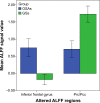Aberrant spontaneous low-frequency brain activity in male patients with severe obstructive sleep apnea revealed by resting-state functional MRI
- PMID: 25653530
- PMCID: PMC4311758
- DOI: 10.2147/NDT.S73730
Aberrant spontaneous low-frequency brain activity in male patients with severe obstructive sleep apnea revealed by resting-state functional MRI
Abstract
Background: The majority of previous neuroimaging studies have demonstrated both structural and functional abnormalities in obstructive sleep apnea (OSA). However, few studies have focused on the regional intensity of spontaneous fluctuations during the resting state and the relationship between the abnormal properties and the behavioral performances. In the present study, we employed the amplitude of low-frequency fluctuation (ALFF) method to explore the local features of spontaneous brain activity in OSA patients (OSAs).
Methods: Twenty-five untreated male severe OSAs and 25 age-matched and years-of-education-matched male good sleepers (GSs) were included in this study. The ALFF method was used to assess the local features of spontaneous brain activity. The mean signal values of the altered ALFF areas were analyzed with receiver operating characteristic curve. Partial correlation analysis was used to explore the relationship between the observed mean ALFF values of the different areas and the behavioral performances.
Results: Compared with GSs, OSAs had significantly higher scores for body mass index, apnea-hypopnea index, arterial oxygen saturation <90%, arousal index, and Epworth Sleepiness Scale (ESS) score; furthermore, OSAs had significantly lower scores for rapid eye movement sleep and in the Montreal Cognitive Assessment (MoCA). Compared with GSs, OSAs showed significant lower-ALFF areas in the cluster of the right precuneus and bilateral posterior cingulate gyrus, as well as a higher-ALFF area in the left inferior frontal gyrus. The area under the curve values of the lower- and higher-ALFF areas were 0.90 and 0.93, respectively. Further diagnostic analysis exhibited that the sensibility and specificity of the two clusters were 80% and 92%, respectively. The mean signal value of the lower-ALFF cluster displayed significant positive correlations with lowest oxygen saturation (r=0.447, P=0.025) and MoCA score (r =0.405, P=0.045).
Conclusion: OSAs may involve in a dysfunction in the default mode network and an adaptive compensatory response in the frontal lobe, which reflect the underlying pathophysiology of cognitive impairment.
Keywords: amplitude of low-frequency fluctuation; blood oxygen-level-dependent; functional magnetic resonance imaging; obstructive sleep apnea; resting state; spontaneous activity.
Figures



Similar articles
-
Altered intrinsic regional brain activity in male patients with severe obstructive sleep apnea: a resting-state functional magnetic resonance imaging study.Neuropsychiatr Dis Treat. 2014 Sep 19;10:1819-26. doi: 10.2147/NDT.S67805. eCollection 2014. Neuropsychiatr Dis Treat. 2014. PMID: 25278755 Free PMC article.
-
Frequency-specific alterations in intrinsic low-frequency oscillations in newly diagnosed male patients with obstructive sleep apnea.Front Neurosci. 2022 Sep 30;16:987015. doi: 10.3389/fnins.2022.987015. eCollection 2022. Front Neurosci. 2022. PMID: 36248662 Free PMC article.
-
Altered spontaneous brain activity patterns in patients with retinal vein occlusion indicated by the amplitude of low-frequency fluctuation: A functional magnetic resonance imaging study.Exp Ther Med. 2019 Sep;18(3):2063-2071. doi: 10.3892/etm.2019.7770. Epub 2019 Jul 12. Exp Ther Med. 2019. PMID: 31410162 Free PMC article.
-
Aberrant Awake Spontaneous Brain Activity in Obstructive Sleep Apnea: A Review Focused on Resting-State EEG and Resting-State fMRI.Front Neurol. 2020 Aug 11;11:768. doi: 10.3389/fneur.2020.00768. eCollection 2020. Front Neurol. 2020. PMID: 32849223 Free PMC article. Review.
-
[Research progress on the effects of childhood obstructive sleep apnea syndrome on cognition and brain functions].Sheng Li Xue Bao. 2023 Aug 25;75(4):575-586. Sheng Li Xue Bao. 2023. PMID: 37583045 Review. Chinese.
Cited by
-
Distinct functional brain abnormalities in insomnia disorder and obstructive sleep apnea.Eur Arch Psychiatry Clin Neurosci. 2023 Mar;273(2):493-509. doi: 10.1007/s00406-022-01485-7. Epub 2022 Sep 12. Eur Arch Psychiatry Clin Neurosci. 2023. PMID: 36094570
-
The Effects of CPAP Treatment on Resting-State Network Centrality in Obstructive Sleep Apnea Patients.Front Neurol. 2022 Mar 28;13:801121. doi: 10.3389/fneur.2022.801121. eCollection 2022. Front Neurol. 2022. PMID: 35418931 Free PMC article.
-
Alternation of brain intrinsic activity in patients with hypertensive retinopathy: a resting-state fMRI study.Aging (Albany NY). 2021 Sep 13;13(17):21659-21670. doi: 10.18632/aging.203510. Epub 2021 Sep 13. Aging (Albany NY). 2021. PMID: 34516404 Free PMC article.
-
Functional cortical changes in relapsing-remitting multiple sclerosis at amplitude configuration: a resting-state fMRI study.Neuropsychiatr Dis Treat. 2016 Nov 25;12:3031-3039. doi: 10.2147/NDT.S120909. eCollection 2016. Neuropsychiatr Dis Treat. 2016. PMID: 27932883 Free PMC article.
-
Altered Percent Amplitude of Fluctuation in Healthy Subjects After 36 h Sleep Deprivation.Front Neurol. 2021 Jan 15;11:565025. doi: 10.3389/fneur.2020.565025. eCollection 2020. Front Neurol. 2021. PMID: 33519662 Free PMC article.
References
-
- Sajkov D, McEvoy RD. Obstructive sleep apnea and pulmonary hypertension. Prog Cardiovasc Dis. 2009;51(5):363–370. - PubMed
-
- Flemons WW, Remmers JE, Gillis AM. Sleep apnea and cardiac arrhythmias: Is there a relationship? Am Rev Respir Dis. 1993;148(3):618–621. - PubMed
-
- Munoz R, Duran-Cantolla J, Martínez-Vila E, et al. Severe sleep apnea and risk of ischemic stroke in the elderly. Stroke. 2006;37(9):2317–2321. - PubMed
LinkOut - more resources
Full Text Sources
Miscellaneous

